-
Key Principles for Good Assurance
- Plan for assurance
- Drive good decisions
- Expert-led and independent
- Culture and tone at the top
- Focus on risks and outcomes
-
Reforms supporting success – enabling project success through good assurance
Since 2021, the Australian Government has invested in strengthening central oversight of digital projects. This central oversight works to ensure best practice is systematically applied as digital projects are designed and delivered across agencies. By driving the adoption of best practice, central oversight plays a key role in giving each digital project the best chance of success.
The Assurance Framework for Digital and ICT Investments mandates global best practice in the use of assurance for digital projects. While assurance doesn’t in itself deliver outcomes, effective assurance is critical to good governance and decision-making. All projects in this report are subject to the Assurance Framework and must apply its ‘key principles for good assurance’. These principles draw on global best practice and, when applied effectively, provide confidence that digital projects will achieve their objectives, without leading to excessive levels of assurance.
The Assurance Framework also includes escalation protocols to support agencies to resolve delivery challenges digital projects might encounter. Central oversight of assurance also ensures that lessons learned from across digital projects are systematically incorporated into the design and delivery of future projects to reduce the risk of delivery issues arising in future.
Reforms supporting success – ensuring digital projects are well designed
The DTA works with agencies to ensure robust and defensible proposals for spending on all new digital projects.
Each proposal must align with the government’s strategies, policies and best practice digital standards as part of the Digital Capability Assessment Process (DCAP).
For complex, high-risk and high-cost digital projects, the DTA offers additional support through the ICT Investment Approval Process (IIAP). This involves working with agencies to develop and mature implementation planning to support success. A comprehensive business case must clearly demonstrate the need for funding, based on thorough policy development, a well-planned approach to delivery and mechanisms for reviewing project progress. This process aids government decision-making on whether to fund large and complex digital project proposals.
The DTA’s digital policies and standards codify best practice and ensure digital projects are positioned to succeed
The policies that apply to digital projects in the Australian Government are constantly being reviewed and updated. This is necessary to ensure they best support agencies in delivering the world-class data and digital capabilities needed to support the missions set out in the Data and Digital Government Strategy.
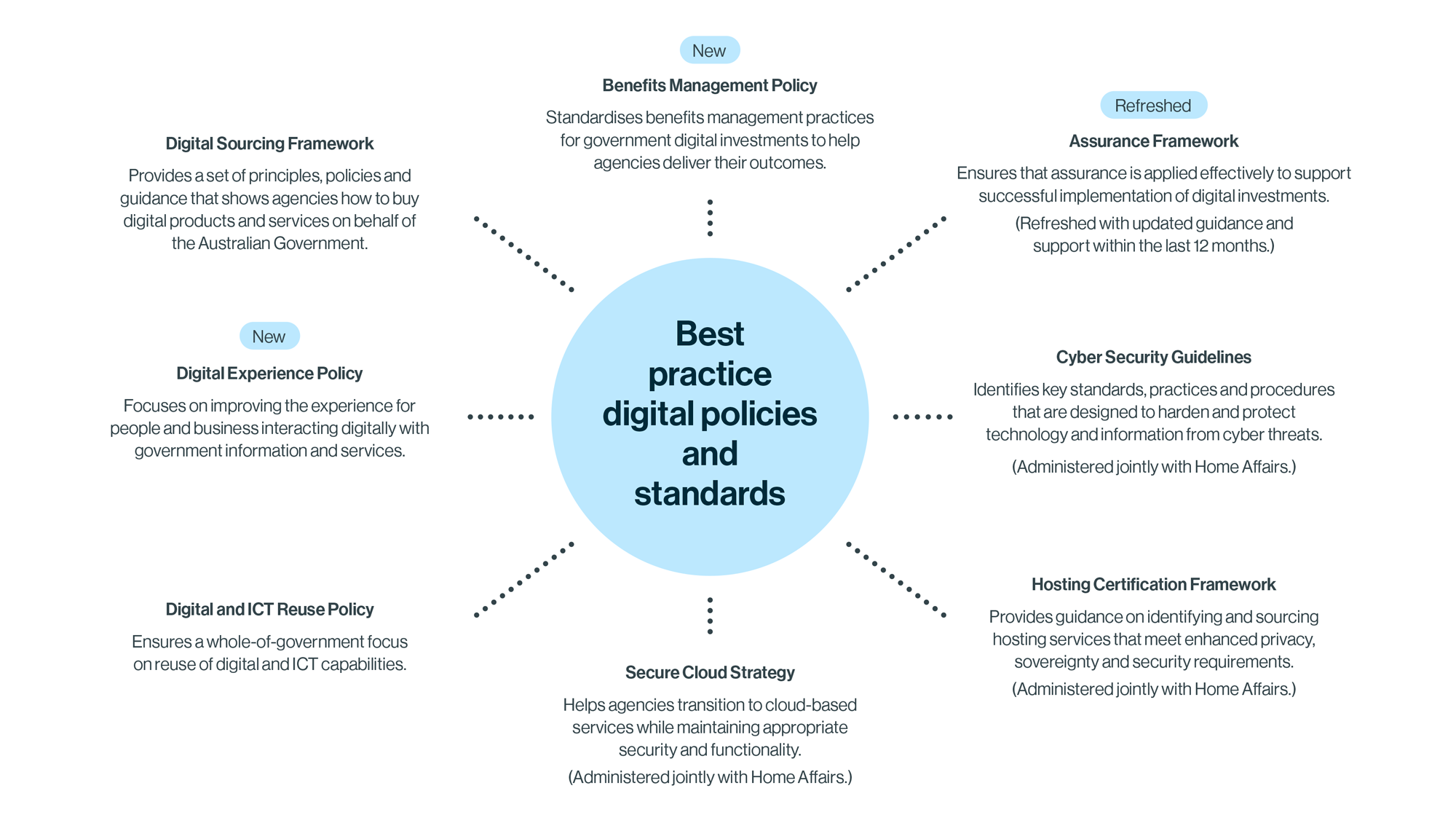
-
Image description
The image shows a central circle with lines leading off to the subheadings.
Image headline (in the centre): 'Best Practice Digital Policies and Standards'
Sub headings:
- Secure Cloud Strategy
- Helps agencies transition to cloud-based services while maintaining appropriate security and functionality.
- (Administered jointly with Home Affairs)
- Hosting Certification Framework
- Provides guidance on identifying and sourcing hosting services that meet enhanced privacy, sovereignty and security requirements.
- (Administered jointly with Home Affairs
- Cyber Security Guidelines
- Identifies key standards, practices and procedures that are designed to harden and protect technology and information from cyber threats.
- (Administered jointly with Home Affairs).
- Assurance Framework (Refreshed)
- Ensure that assurance is applied effectively to support successful implementation of digital investments.
- (Refreshed with updated guidance and support within the last 12 months)
- Benefits Management Policy (New)
- Standardises benefit management practices for government digital investments to help agencies deliver their outcomes.
- Digital Sourcing Framework
- Provides a set of principles, policies and guidance that shows agencies how to buy digital products and services on behalf of the Australian Government.
- Digital Experience Policy (New)
- Focuses on improving the experience for people and businesses interacting digitally with government information and services.
- Digital and ICT Reuse Policy
- Ensures a whole of government focus on reuse of digital and ICT capabilities.
- Secure Cloud Strategy
-
-
-
Reforms supporting success – improving benefits management capability
The Australian Government’s Benefits Management Policy for Digital and ICT-Enabled Investments requires agencies to use best practice benefits management for their digital projects. Projects must identify measurable benefits with clear baselines and targets before funding decisions are taken. The minimum policy requirements are adjusted based on project tier, but all projects must focus on securing benefits in addition to preventing cost and schedule overruns.
The DTA oversees the realisation of benefits and identifies emerging risks across digital projects. We also focus on providing advice, support and training to improve public service capabilities.
Investment in this area aims to ensure that digital projects deliver anticipated benefits to the government and Australians.
-
Disclaimer
“Certain numbers in this report have been rounded to one decimal place. Due to rounding, some totals may not correspond with the sum of the separate figures.”
-
Projects under central oversight
-
Image description
Diagram headline: 'Total number and budget of projects in each delivery confidence rating category, by Tier 1 and Tier 2'
The diagram demonstrates that Tier 1 projects have:
- No projects with high delivery confidence rating
- 11 projects with Medium-High delivery confidence and a total budget of $1.5 billion
- 5 projects with Medium delivery confidence and a total budget of $1.0 billion
- 2 projects with Medium-Low delivery confidence and a total budget of $0.7 billion
- 2 projects with Low delivery confidence and a total budget of $0.5 billion
- No projects had an Unavailable delivery confidence
Tier 2 projects have:
- 8 projects with High delivery confidence and a total budget of $0.5 billion
- 19 projects with Medium-High delivery confidence and a total budget of $5.3 billion, $3.4 billion of this comprising the Resourcing Australia’s Prosperity (RAP) Initiative project, with the remaining 18 projects comprising $2.0 billion.
- 9 projects with Medium delivery confidence and a total budget of $0.6 billion
- 5 projects with Medium-Low delivery confidence and a total budget of $0.6 billion
- No projects had a Low delivery confidence
- 1 project had an Unavailable delivery confidence with a total budget of $18.9 million.
-
-
-
Changes in delivery confidence
New major digital projects are generally starting off well with more than three-quarters reporting High or Medium-High delivery confidence.
The government’s digital projects are being delivered against a backdrop of rapid and continuous technological change. This dynamic environment is reflected in the changes in delivery confidence ratings over the past year as projects move through different stages in their development.
Delivery confidence of projects which have newly entered central oversight
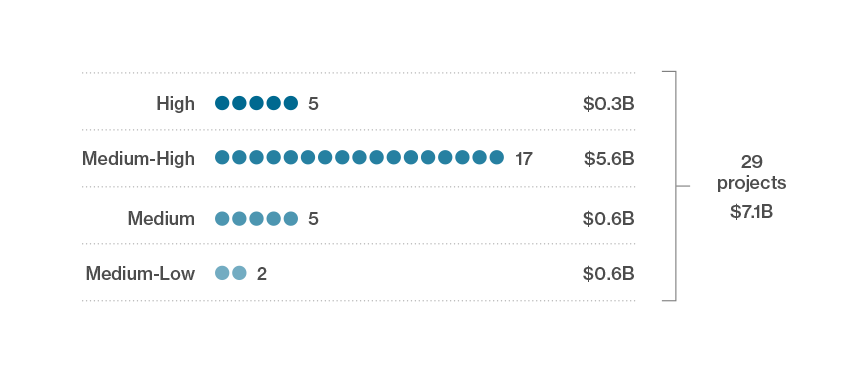
-
Case study: Tax and super
Australian Taxation Office: Creating secure data centres
At a glance
- Tax and super
- ato.gov.au
- $369.7 million investment
Summary
The ATO Data Centre Transformation delivered modern, resilient and secure data centres that keep pace with technology, demand and community expectations, while keeping data secure.
The ATO undertook this once-in-a-generation infrastructure and data centre modernisation program to align with government directives and ensure the ongoing security and integrity of critical data stores.
The importance and complexity of the ATO’s role in the Australian economy means it must provide digital experiences and services that make it easy for the community to engage while also safeguarding taxpayer data.
This complex project overcame many challenges. Many data centre migrations of this size and complexity fail, leaving the organisation in a hybrid state with significant technical debt. The success of the ATO data centre program was largely due to the collective drive and commitment to overcome technical issues.
The outcome was to deliver the most significant technology transformation for the ATO in 30 years.
"As the Australian Government’s principal revenue collection agency, data underpins everything we do. Our data stores are growing every year, so keeping our systems safe and protecting the personal information entrusted to us by taxpayers is paramount."
Michael Rowell
ATO Deputy Commissioner and Senior Responsible OfficialThe outcomes delivered directly contributed to or created business benefits for the ATO and the broader community. These include fewer service interruptions so clients can access ATO services when they need to with greater confidence, as well as reduced national security risk for sensitive data.
Note: This project is not featured in this report as it closed before the start of public reporting in 2024. This project is, however, enabling delivery of current ATO projects and is included as an example for this reason.
Off -
Your responsibilities
To successfully meet this criterion, you need to:
- develop a business case for change
- survey the policy and service landscape
- understand your service’s life cycle
- adopt an agile methodology
-
-
-
Nearly two thirds of the Tier 1 and 2 projects are on track
Projects reporting High or Medium-High delivery confidence Total projects (Tier 1 and 2) 62 Number with High or Medium-High delivery confidence 38 Percentage with High or Medium-High delivery confidence 61.3% Total budget with High or Medium-High delivery confidence $7.3 billion Note: High or Medium-High delivery confidence indicates projects are on track to deliver agreed outcomes. Common success factors among projects rated High or Medium-High are:
- experienced staff on the project team
- effective governance models keeping pace with the needs of the project
- mature approaches to risk and issue management
- effective partnering and collaboration between agencies and delivery partners.
Reforms supporting success – preparing senior leaders to lead digital projects successfully
Senior Responsible Officials for digital projects have a key role in ensuring these projects succeed in delivering expected benefits on schedule and on budget. To support these officials, a mandatory program is starting early this year to ensure they are equipped to confidently lead digital projects successfully. This program includes a simulation of a digital project across its life with a focus on building capability in assurance, benefits management, governance, project remediation, and commercial acumen. Following final trials, the program will be available through the Australian Public Service Academy and mandated for all leaders of the major digital projects included in this report.
While most projects are on-track, some projects are reporting lower levels of delivery confidence
Projects reporting Medium or lower delivery confidence Total projects (Tier 1 and 2) 62 Number with Medium or Lower delivery confidence 23 Percentage of total projects with Medium or lower delivery confidence 37.1% Total budget of projects with Medium or lower delivery confidence $3.5 billion Tier 1 projects with Medium or lower delivery confidence 45.0% Tier 2 projects with Medium or lower delivery confidence 33.3% As this table shows, a higher proportion of Tier 1 projects (45.0%) are reporting a delivery confidence of Medium or lower compared with Tier 2 projects (33.3%), likely reflecting the added risks and complexities inherent to these projects.
Common themes among projects rated Medium or lower are:
- dependencies on changes to, or introduction of, new legislation
- the complex nature of the technological solutions being implemented – including where integration of systems across organisations and even jurisdictions is required to achieve outcomes
- where digital transformation is occurring alongside major organisational changes, or at a pace the organisation is struggling to sustain (for example, due to multiple concurrent digital projects putting pressure on an agency’s enterprise capability)
- challenges attracting and retaining staff with the required skills including in digital disciplines such as cyber security, as well as in project/program management disciplines such as benefits, change, risk, budget management and integrated scheduling.
Projects reporting lower levels of delivery confidence are generally challenged by more than one of these themes. As noted in the July 2023 Review of the Modernising Business Registers Program, ‘the difficulty of effectively implementing a digital and ICT transformation project increases exponentially with each additional layer of complexity’ (Treasury 2023 p. 338).
Reforms supporting success – reducing risk through robust assurance and governance
Parallel development of legislation and digital capabilities can lead to significant delivery risks, including budget overruns, delays and, in extreme cases, project failures. Sometimes urgent factors make this concurrent work necessary, but where this occurs the associated risk must be managed carefully.
For high-risk digital projects, robust assurance and governance are crucial. The DTA seeks to mitigate risk by adding central funding and governance controls. An example is recommending the government quarantine part or all project funding, releasing it upon successful early discovery work and other proof points that indicate likely successful delivery.
Some continuing projects are reporting delivery difficulties
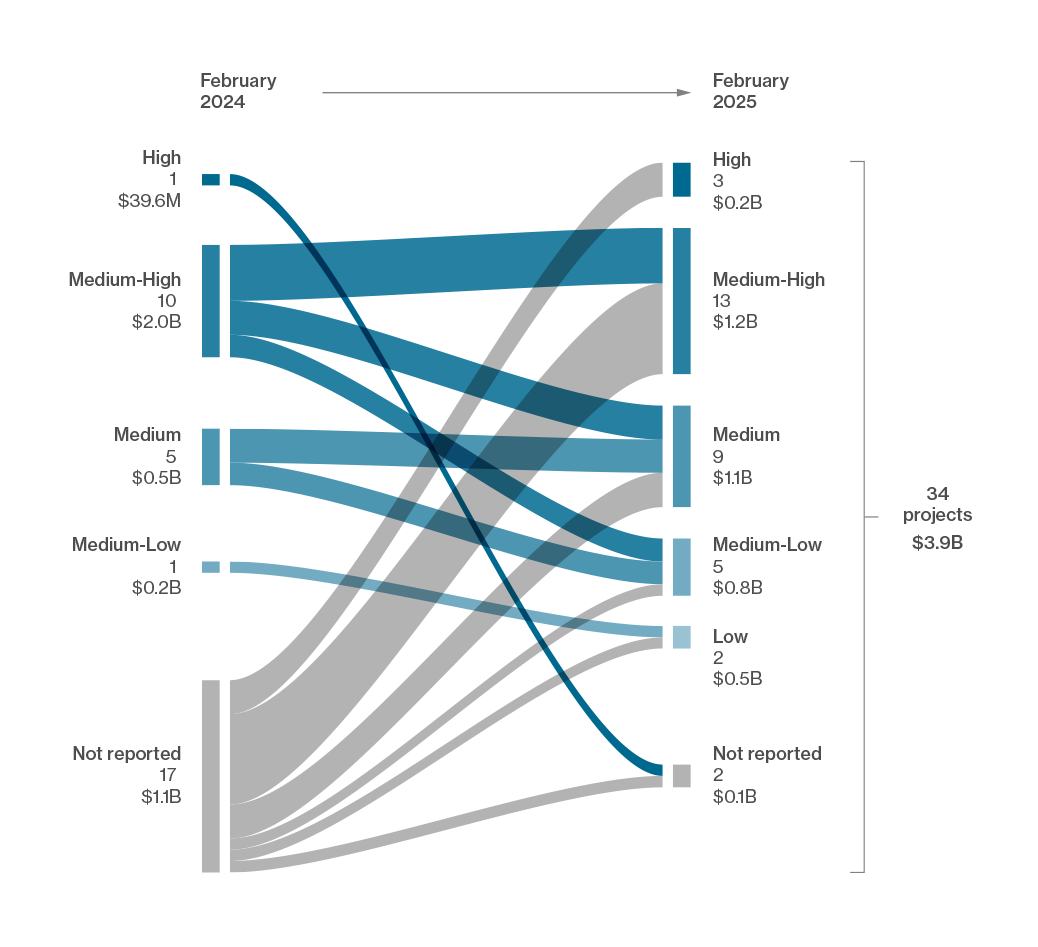
Note: One project reporting a high delivery confidence in February 2024 is no longer reported since being reclassified from a Tier 2 to a Tier 3. This project now falls outside the scope for inclusion of delivery confidence information.
-
Image description
Headline: Some continuing projects are reporting delivery difficulties
Subheading: Change in delivery confidence of projects which were included in the February 2024 report
Sankey chart depicting the flow of delivery confidence ratings for projects continuing under oversight from February 2024, indicating starting delivery confidence ratings, to their delivery confidence ratings in February 2025, with numbers of projects and total budgets ascribed to each delivery confidence category.
High delivery confidence: 1 project with a total budget of $39.6 million had high delivery confidence in February 2024, did not report delivery confidence in February 2025.
Medium-High delivery confidence: 10 projects with a total budget of $2.0 billion had medium-high delivery confidence in February 2024. In February 2025 this stayed at medium-high delivery confidence for 5 of these projects, reduced to medium delivery confidence for 3 of these projects and dropped to medium-low delivery confidence for 2 of these projects.
Medium delivery confidence: 5 projects with a total budget of $0.5 billion had a medium delivery confidence in February 2024. In February 2025 this remained at medium delivery confidence for 3 of these projects, with 2 reducing to medium-low delivery confidence.
Medium-Low delivery confidence: 1 project with a total budget of $0.2 billion had medium-low delivery confidence in February 2024, reducing to low delivery confidence in February 2025.
Not reported delivery confidence: 17 projects with a total budget of $1.1 billion did not report delivery confidence in February 2024. In February 2025, 3 of these projects reported high delivery confidence, 8 reported medium-high, 3 reported medium, 1 reported medium-low, 1 reported low delivery confidence and 1 continued to not report delivery confidence.
In February 2024, 1 project had high delivery confidence, 10 had medium-high delivery confidence, 5 had medium delivery confidence, 1 had medium-low delivery confidence and 17 did not report delivery confidence.
In February 2025, 3 projects had high delivery confidence, 13 had medium-high delivery confidence, 9 had medium delivery confidence, 5 had medium-low delivery confidence, 2 had low delivery confidence and 2 did not report delivery confidence.
Off -
-
-
Of the 17 continuing Tier 1 and 2 projects that reported delivery confidence in February 2024, 11 projects either maintained or dropped in delivery confidence to Medium or lower in February 2025. These projects are routinely managing 3 or more delivery challenges that affected their assessments. Common trends include: financial pressures; scope complexities; resourcing constraints; tight schedules; technical issues; and a need to improve project management maturity.
While the goal is to see DCAs improving over time, it is common for delivery issues to worsen before they improve, especially when complex technical issues are involved. Some projects reporting lower DCAs are depending on the successful delivery of other projects as part of a wider reform program. While they have been closely monitoring delivery, setbacks in other projects can result in these projects being delayed, as key components required to stay on track become unavailable when needed.
Reforms supporting success – using new ways of collecting data to enable timely support and course corrections
In July 2024, the DTA began a Project Data Reporting Standard (PDRS) trial. The trial is testing a new approach to enable more seamless and timely central tracking of project performance across the Australian Government, using ‘natural systems’.
Using ‘natural systems’ means project data is collected from internal reporting projects are preparing for their governance boards, rather than requiring agencies to prepare specific reporting for central tracking purposes.
This approach is:
- improving the quality of reporting and advice the DTA can provide to stakeholders across the Australian Government – including by enabling data to be collected more frequently
- supporting decision-making by ensuring digital governance boards consistently have the minimum necessary information required to enable good decisions (a condition of the trial is that a minimum set of information must be provided to the board)
- improving the experience of agencies providing data to the DTA in our oversight role.
The trial is enabling more timely and effective central oversight of digital projects, helping ensure support can be provided where it needed most and at the earliest stage when the chance of charting a course back to green is greatest.
-
Disclaimer
“Certain numbers in this report have been rounded to one decimal place. Due to rounding, some totals may not correspond with the sum of the separate figures.”
-
Projects that left the portfolio
-
How the Australian Government’s digital projects are performing
This section sets out how digital projects are performing. Digital projects present unique challenges and the reforms set out in previous sections are playing a key role in ensuring the conditions exist for each and every project included in this report to succeed.
Projects worth $7.3 billion of total budget are on-track
Consistent DCAs for major digital projects provide an overview of each project’s performance, spotlighting where support is needed most. This transparency also aids in reforms aimed at creating optimal conditions for digital projects to succeed and enhance public services and people’s lives.
Across the 2 years of reporting, the DCAs show many projects in the portfolio are on track to deliver agreed outcomes. This reflects the easing of technology supply disruptions related to the COVID-19 pandemic and the ongoing investment in strengthening how the Australian Government designs and delivers its digital projects.
Total number and budget of projects in each delivery confidence rating category (Tier 1 and Tier 2)
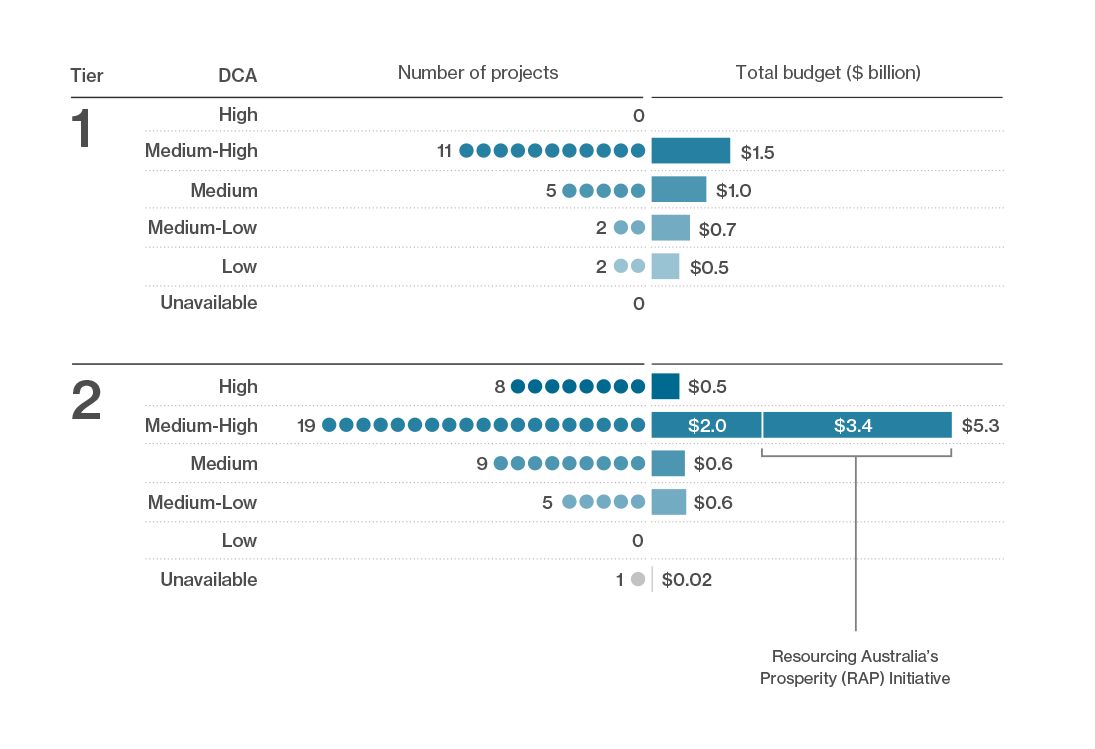
-
References
- Infrastructure and Projects Authority, 2024, IPA_Annual_Report_2023-24, accessed 21 February 2024.
- The Australian Government Treasury, 2023, Independent Review into Modernising Business Registers, accessed 21 February 2024.
-
Improving transparency for Australians on the performance of digital projects
In recent years, the Australian Government has actively invested not just in new digital projects but in understanding what projects are underway and how they can best be supported to succeed. Transparency is an essential ingredient for good governance and this section sets out the improvements which have been made to ensure Australians know how their digital projects are performing.
Almost all Tier 1 and 2 projects now have delivery confidence assessments
Tier 1 and 2 digital projects must undertake regular delivery confidence assessments (DCAs) under the Assurance Framework for Digital and ICT Investments. DCAs indicate how likely a project is to meet its objectives at a given point in time. DCA ratings range from High to Low (see Appendix for details).
A lower DCA rating signals issues or risks that need to be addressed. However, a low rating does not necessarily mean a project will fail. Instead, it’s an early warning system that allows for timely interventions to support project teams in mitigating risks and overcoming challenges. By taking the right steps, projects can recover from lower delivery confidence ratings and go on to deliver expected outcomes for Australians on budget and on schedule.
The DTA plays a crucial role in this process. When delivery confidence decreases, we work closely with agencies to make sure they take the right measures. This involves:
- providing guidance, resources and support to project teams
- facilitating the best use of assurance processes
- promoting strategies to address issues as early as possible, when course corrections are more likely to succeed.
Ultimately, this collaborative effort aims to enhance the likelihood of successful project delivery, ensuring that investments provide expected benefits to Australians and businesses.
Since the introduction of the Australian Government’s Digital and ICT Investment Oversight Framework in November 2021, there has been a concerted focus on increasing understanding of how digital projects are performing, as well as the conditions that need to exist to best support their success.
In the last report in February 2024, 52.1% of Tier 1 and 2 projects included a delivery confidence assessment. In February 2025, this has increased to 98.4%.
-
52.1% to 98.4% is the 2024–2025 increase in DCAs
In the last report in February 2024, 52.1% of Tier 1 and 2 projects included a delivery confidence assessment. In February 2025, this has increased to 98.4%. Through concerted focus on strengthening how digital projects are overseen, Australians now know how their major digital projects are performing.
-
Transparency and understanding of project performance is increasing
Efforts have focused on improving the availability and quality of DCAs. These are conducted by skilled independent assurers whenever possible to ensure an objective perspective. In this report, 80.3% of assessments were completed by independent assurers under the Assurance Framework, with 90.0% of Tier 1 projects meeting this standard. The remaining delivery confidence ratings reflect self-assessments by the relevant agency.
Change in delivery confidence ratings over 12 months
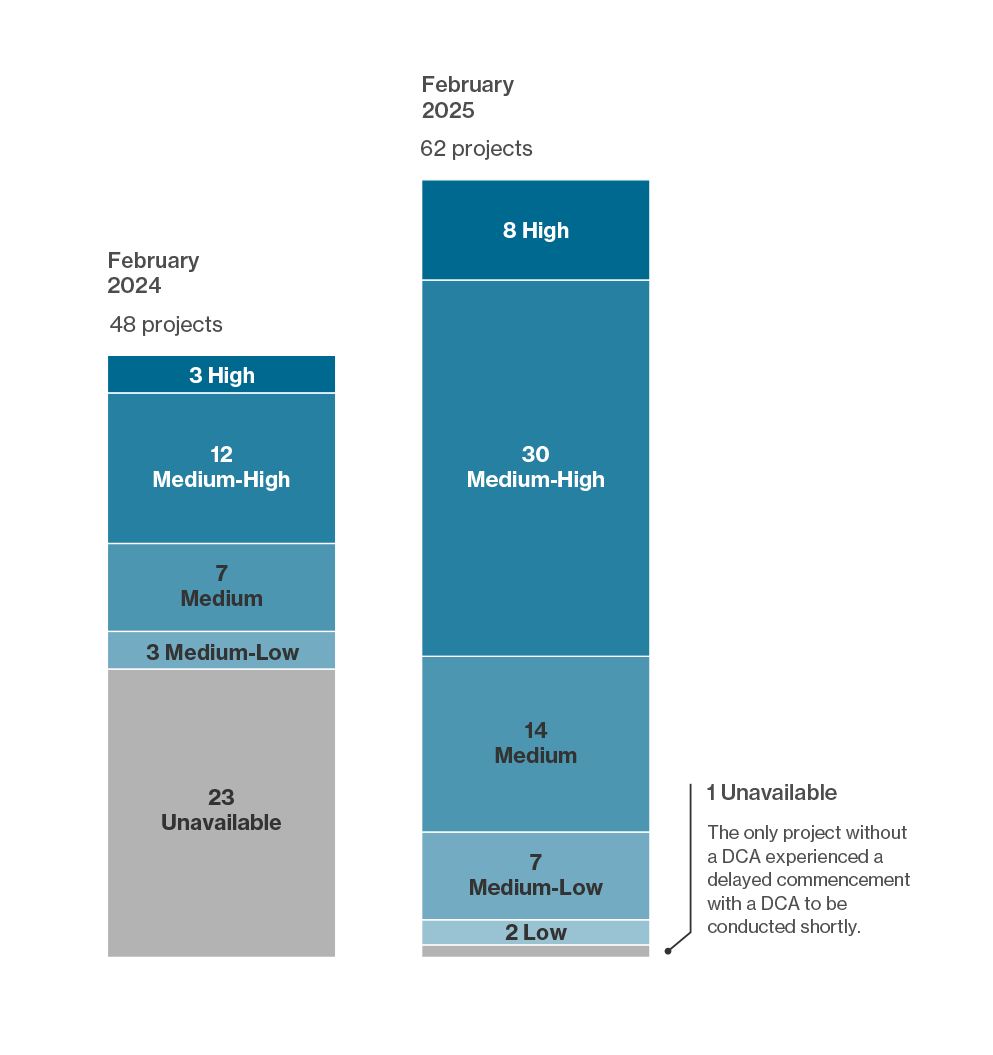
Connect with the digital community
Share, build or learn digital experience and skills with training and events, and collaborate with peers across government.

